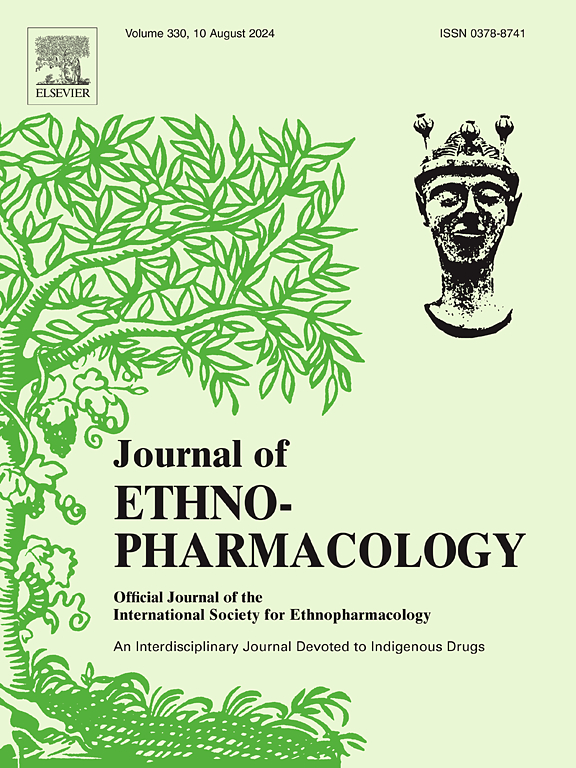通过代谢谱探讨炭化伤寒花粉治疗血瘀证的作用机制:止血无瘀的协同作用。
IF 5.4
2区 医学
Q1 CHEMISTRY, MEDICINAL
引用次数: 0
摘要
民族药理学相关性:祛瘀止血中药(RBSB-TCM)是一类独特的中药,具有舒张血管、化瘀止血的作用。碳化型台风孢粉(CTP)是由台风孢粉(TP)经炭化而得,已成为一种特别有价值的治疗剂。它已广泛应用于临床治疗血瘀证(BSS)引起的出血性疾病。然而,CTP实现促进血流和止血双重协同作用的潜在机制尚不清楚。研究目的:本研究试图从代谢物谱的角度,探讨CTP祛瘀止血的根本机制。材料与方法:首先,采用超高效液相色谱-四极杆飞行时间质谱(UHPLC-Q-TOF-MS)联用技术,结合MetabolitePilot 2.0.4软件,对口服CTP大鼠体内的化学成分、吸收成分和代谢物进行鉴定。随后,采用BSS大鼠和脑出血斑马鱼模型,系统研究了CTP的药理作用。具体而言,对大鼠凝血功能和组织病理学的影响,以及对斑马鱼脑出血的影响进行了全面的评估。应用基于大鼠血浆的非靶向代谢组学分析代谢谱变化,揭示潜在的作用机制。肠道微生物组分析和系统分子生物学实验进一步证实了其潜在机制。结果:从肝、心、脾、肺、肾、小肠、子宫和血清中发现34种原型化学物质和71种代谢物。CTP改善异常凝血系统,促进血液循环,减轻BSS引起的病理损伤。血浆代谢组学显示,BSS显著改变了胆汁酸(BA)代谢和花生四烯酸(AA)代谢。肠道菌群分析和粪便菌群移植(FMT)实验进一步证实了CTP对肠道菌群的调节作用。这种调节促进了BA的产生,激活了内皮一氧化氮合酶(eNOS),导致一氧化氮(NO)水平升高。这些变化有助于CTP祛瘀的治疗效果。系统分子生物学实验表明,CTP激活了AA代谢途径的关键组分。它促进plc γ - 1磷酸化,增加细胞内Ca2+水平,上调COX-2表达。此外,CTP促进了aa相关代谢物的产生,包括6-酮前列腺素F1α(6-酮前列腺素F1α)、前列腺素E2 (PGE2)和血栓素B2 (TXB2)。它还增加了AA代谢相关基因的转录,如plc - γ1、PTGS2a、PTGS2b、PTGIS、PTGES、TXBAS和vWF。结论:CTP可通过plc - γ - 1/Ca2+/COX-2促进AA代谢物的生成,起到止血作用,同时可通过肠道微生物-胆汁酸轴增强eNOS活性和NO合成,起到祛瘀作用。这两种作用相互平衡,达到止血不瘀血的目的。本文章由计算机程序翻译,如有差异,请以英文原文为准。

Exploring the mechanism of Carbonized Typhae Pollen in treating blood stasis syndrome through metabolic profiling: the synergistic effect of hemostasis without blood stasis
Ethnopharmacological relevance
Removing blood stasis and stopping bleeding traditional Chinese medicines (RBSB-TCM) formed a unique class of TCM, characterized by vasodilating, removing stasis and hemostatic effects. Carbonized Typhae Pollen (CTP), derived from Typhae Pollen (TP) through carbonization, has emerged as a particularly valuable therapeutic agent. It has been widely used in clinical practice to treat hemorrhagic disorders caused by blood stasis syndrome (BSS). However, the potential mechanism for CTP to achieve the dual synergistic effect of promoting blood flow and hemostasis remains unclear.
Aim of the study
From the standpoint of metabolite profiles, this study attempts to investigate the fundamental mechanism of CTP in the elimination of blood stasis and the cessation of bleeding.
Materials and methods
First, chemical constituents, absorbed constituents and metabolites in rats following oral administration of CTP were identified by ultra-high performance liquid chromatography coupled with the quadrupole time-of-flight mass spectrometry (UHPLC-Q-TOF-MS) method combined with MetabolitePilot 2.0.4 software. Subsequently, the pharmacological effects of CTP were systematically investigated using rat models with BSS and zebrafish with cerebral hemorrhage. Specifically, the impact on coagulation function and histopathology in rats, as well as the effect on cerebral hemorrhage in zebrafish, were thoroughly evaluated. Untargeted metabolomics based on rat plasma was applied to analyze the metabolic profile changes, revealing the potential action mechanism. The underlying mechanism was furtherly confirmed by gut microbiome analysis and systemic molecular biology experiments.
Results
34 prototype chemicals and 71 metabolites from the liver, heart, spleen, lung, kidney, small intestine, uterus, and serum were found. CTP improved the abnormal coagulation system, promoted blood circulation, and reduced pathological damage caused by BSS. Plasma metabolomics revealed that BSS significantly altered bile acid (BA) metabolism and arachidonic acid (AA) metabolism. Gut microbiome analysis and fecal microbiota transplantation (FMT) experiments further demonstrated that CTP modulated the gut microbiota. This modulation promoted BA production and activated endothelial nitric oxide synthase (eNOS), leading to increased nitric oxide (NO) levels. These changes contributed to the therapeutic effect of CTP in removing blood stasis. Systemic molecular biology experiments showed that CTP activated key components of the AA metabolic pathway. It promoted PLCγ1 phosphorylation, increased intracellular Ca2+ levels, and upregulated COX-2 expression. In addition, CTP enhanced the production of AA-related metabolites, including 6-keto-prostaglandin F1α (6-keto-PGF1α), prostaglandin E2 (PGE2), and thromboxane B2 (TXB2). It also increased the transcription of AA metabolism-related genes, such as PLCγ1, PTGS2a, PTGS2b, PTGIS, PTGES, TXBAS, and vWF.
Conclusions
CTP could promote the generation of AA metabolites through PLCγ1/Ca2+/COX-2 to stop bleeding, while also enhancing eNOS activity and NO synthesis through gut microbiota-bile acid axis to remove blood stasis. These two effect were balanced to achieve hemostasis without blood stasis.
求助全文
通过发布文献求助,成功后即可免费获取论文全文。
去求助
来源期刊

Journal of ethnopharmacology
医学-全科医学与补充医学
CiteScore
10.30
自引率
5.60%
发文量
967
审稿时长
77 days
期刊介绍:
The Journal of Ethnopharmacology is dedicated to the exchange of information and understandings about people''s use of plants, fungi, animals, microorganisms and minerals and their biological and pharmacological effects based on the principles established through international conventions. Early people confronted with illness and disease, discovered a wealth of useful therapeutic agents in the plant and animal kingdoms. The empirical knowledge of these medicinal substances and their toxic potential was passed on by oral tradition and sometimes recorded in herbals and other texts on materia medica. Many valuable drugs of today (e.g., atropine, ephedrine, tubocurarine, digoxin, reserpine) came into use through the study of indigenous remedies. Chemists continue to use plant-derived drugs (e.g., morphine, taxol, physostigmine, quinidine, emetine) as prototypes in their attempts to develop more effective and less toxic medicinals.
 求助内容:
求助内容: 应助结果提醒方式:
应助结果提醒方式:


